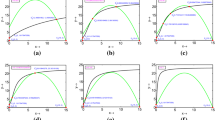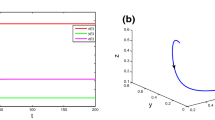Abstract
This paper aims at the detailed numerical analysis of a cyclic three species predator–prey model where the prey consumes only a part of the super-predator population. Such a model exists only when the prey acts as an omnivore. Here, we have investigated the dynamical behaviour of the prey, middle predator and super-predator. All the possible equilibrium points of the model are computed and the existence and stability condition of the equilibrium states are determined. The phase portraits are generated for different sets of parameter values. The long term behaviour of the system is investigated by studying the bifurcation structure and nature of the attractors, thereby identifying the domain of chaos, as each of the control parameter is varied independently. Finally, we show that a transition from chaotic domain to escape or vice-versa of the predator in a small region of the parameter plane leads to a fractal structure.








Similar content being viewed by others
References
A J Lotka, Elements of mathematical biology (Williams and Wilkins, Baltimore, USA, 1925)
V Volterra, Mem. Acad. Lincei. 2, 31 (1926)
N Kasarinoff and P van der Deiesch, Math. Biosci. 39, 124 (1978)
Y Kuang, Appl. Anal. 29, 269 (1988)
R R Dodd, J. Math. Biol. 35, 432 (1997)
G S K Walkowicz, SIAM J. Appl. Math. 48, 592 (1988)
K P Harikrishnan, Pramana – J. Phys.90: 24 (2018)
R M May, J. Theor. Biol. 51(2), 511 (1975)
A Hastings and T Powell, Ecology 72, 8956 (1991)
A Klebanoff and A Hastings, J. Math. Biol 32, 427 (1994)
Y A Kuznetsov, O De Feo and S Rinaldi, SIAM J. Appl. Math. 62(2), 462 (2001)
Temple H Fay and Johanna C Greeff, Ecol. Modell. 196, 237 (2006)
Erica Chauvet, Joseph E Paullet, Joseph P Previte and Zac Walls, Math. Mag.75(4), 243 (2002)
M B Elowitz and S Leibler, Nature 403, 335 (2000)
B Kerr, M A Riley, M W Feldman and B J M Bohannan, Nature 418, 171 (2002)
B Sinervo and C M Lively, Nature 380, 240 (1996)
D R Taylor and L W Aarssen, Am. Nat. 136, 305 (1990)
D D Cameron, A White and J Antonovics, J. Ecol. 97(6), 1311 (2009)
R A Lankau and S Y Strauss, Science 317(5844), 1561 (2007)
B C Kirkup and M A Riley, Nature 428, 412 (2004)
J Hofbauer and K Sigmund, Evolutionary games and population dynamics (Cambridge University Press, Cambridge, 1998)
L Frachebourg, P L Krapivsky and E Ben-Naim, Phys. Rev. E 54, 6186 (1996)
A Provata, G Nicolis and F Baras, J. Chem. Phys. 110, 8361 (1999)
G Szabó and T Czáran, Phys. Rev. E 63(6), 061904 (2001)
P P Saratchandran, K C Ajithprasad and K P Harikrishnan, Annu. Rev. Chaos Theory Bifurc. Dynam. Syst. 5, 10 (2015)
Abd-Elalim A Elsadany, Comp. Ecol. Software 2(2), 124 (2012)
Arild Wikan and Ørjan Kristensen, Disc. Dynam. Nature Soc.2019, 1 (2019)
P V Ivanchikov and L V Nedorezov, Comput. Ecol. Software1(2), 86 (2011)
Azmy S Ackleh and Patrick De Leenheer, J. Biol. Dynam.2(4), 415 (2008)
Q Liu and R Xu, Nonlinear Phenom. Complex Syst. 2(6), 579 (2003)
M R Sagaya Raj, A G M Selvam and R Janagaraj, Int. J. Emerging Res. Management Technol.2(11), 27 (2013)
B Hari Prasad and N Ch Pattabhi Ramacharyulu, Adv. Appl. Sci. Res. 3(6), 3491 (2012)
V I Yukalov, E P Yukalova and D Sornette, Modeling symbiosis by interactions through species carrying capacities, arXiv:1003.2092 [physics.bio-ph] (2012)
S N Elaydi, An introduction to difference equations (Springer, New York, 1996)
Author information
Authors and Affiliations
Corresponding author
Rights and permissions
About this article
Cite this article
Krishnadas, M., Saratchandran, P.P. & Harikrishnan, K.P. Chaos in a cyclic three-species predator–prey system with a partial consumption of superpredator. Pramana - J Phys 94, 75 (2020). https://doi.org/10.1007/s12043-020-1942-9
Received:
Revised:
Accepted:
Published:
DOI: https://doi.org/10.1007/s12043-020-1942-9




